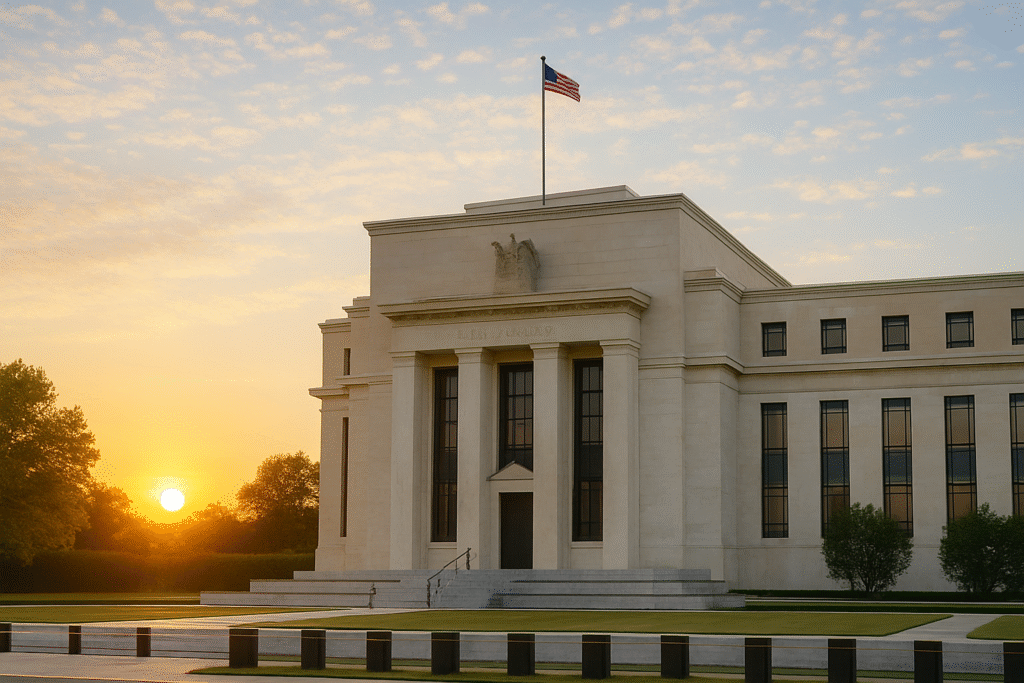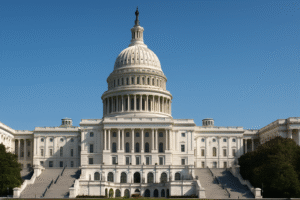Duration & Credit Pulse
Executive Summary
Bottom Line: The Federal Reserve's first rate cut in September 2025 triggered a paradoxical fixed income response, with Treasury yields climbing despite the 25 basis point easing to 4.0-4.25%. The 10-year yield rose 5 basis points to 4.18% as stronger-than-expected economic data—including GDP revised up to 3.8% growth and jobless claims at just 218,000—challenged aggressive easing expectations, while credit spreads compressed to historic extremes with Investment Grade at 71 basis points (3rd percentile) and High Yield at 253 basis points (1st percentile), creating the most extreme divergence between rate and credit risk pricing since 2007.
Duration Dashboard
| Maturity | Sept 21, 2025 | Sept 28, 2025 | Weekly Δ | 5-Year Percentile |
|---|---|---|---|---|
| 2‑Year | 3.57% | 3.64% | +7 bp | 16th %ile (low) |
| 5‑Year | 3.68% | 3.77% | +9 bp | 30th %ile (middle range) |
| 10‑Year | 4.13% | 4.18% | +5 bp | 54th %ile (middle range) |
| 30‑Year | 4.75% | 4.75% | 0 bp | 81st %ile (elevated) |
Post-Fed Cut Paradox: Yields Rise Despite Easing
Curve Analysis: The 2s30s spread remained at 111 basis points, with short rates anchored at historically low percentiles (2-year at 16th) while long bonds stayed elevated (30-year at 81st percentile). This stark percentile divergence—shorts near multi-year lows, longs near highs—reveals a curve positioned for persistent inflation rather than aggressive Fed easing, with term premium demands overwhelming monetary policy signals.
The week's price action shattered conventional wisdom about monetary policy transmission. Despite the Fed delivering its first cut since 2020, the 10-year yield climbed to 4.18% as GDP running at 3.8% and jobless claims at just 218,000 suggested the economy needed no stimulus. This wasn't the labor market weakness Powell cited to justify easing—it was an economy firing on all cylinders receiving unnecessary accommodation.
Credit Pulse
| Metric | Sept 21, 2025 | Sept 28, 2025 | Weekly Δ | 5-Year Percentile |
|---|---|---|---|---|
| IG OAS | 68 bp | 71 bp | +3 bp | 3rd %ile (extremely tight) |
| HY OAS | 245 bp | 253 bp | +8 bp | 1st %ile (extremely tight) |
| VIX Index | 15.45 | 15.29 | -0.16 | 33rd %ile (middle range) |
Credit markets reached historic extremes with investment-grade spreads at just 71 basis points (3rd percentile) and high-yield at 253 basis points (1st percentile), levels that suggest complete complacency about corporate default risk. The compression occurred despite mounting evidence of consumer stress, with credit card delinquencies hitting their highest levels since 2011 according to Fed data. This disconnect between spreads at multi-decade tights and deteriorating fundamentals created what market veterans called the most extreme mispricing of credit risk since 2007, driven by technical flows overwhelming fundamental analysis.
📊 Technical Flows & Positioning Dynamics
Weekly Fund Flows (September 17 Week)
- • Taxable Bond Funds: +$16.62 billion inflows
- • ETF Net Issuance: +$28.56 billion (overwhelming mutual fund outflows of -$17.37B)
- • Municipal Bonds: +$2.09 billion (tax-equivalent yields compelling)
- • High Yield: +$1.8 billion despite spreads at 1st percentile
Primary Market Dynamics
- • September Issuance: 50 borrowers (busiest month in 3 years)
- • Oversubscription: Average 5x vs typical 2-3x
- • New Issue Concessions: Just 1.1bp vs 3.3bp YTD average
- • Rising Stars vs Fallen Angels: 3:1 ratio supporting technicals
Positioning Extremes
- • Credit Long Positioning: 98th percentile per CFTC data
- • Duration Shorts: Near record levels betting on higher yields
- • Dealer Inventory: Investment grade at capacity, limiting market making
- • Real Money: Pension/insurance buyers absent, replaced by fast money
⚠️ Technical Override Warning: The $45 billion weekly technical bid into credit markets is completely disconnecting spreads from fundamentals. When flows reverse—and they always do—the unwind from IG at 71bp (3rd percentile) and HY at 253bp (1st percentile) will be swift and unforgiving. Similar technical extremes preceded the 2007 credit crisis and the 2020 pandemic selloff. Passive indexing has eliminated price discovery.
US Macroeconomic Assessment – Fed Cuts Despite 3.8% GDP Growth
The week of September 21-28 marked a historic inflection point as the Federal Reserve initiated its first easing cycle since 2020, cutting rates 25 basis points despite GDP growth running at 3.8% annualized and core inflation at 2.9%—well above the 2% target. This disconnect between robust economic data and dovish policy created immediate market dislocations, with Treasury yields rising rather than falling as investors questioned the coherence of easing into strength. Chair Powell's September 23 speech attempted to justify the move as "risk management," acknowledging that "near-term risks to inflation are tilted to the upside and risks to employment to the downside." Yet with jobless claims at just 218,000—17,000 below consensus—the employment rationale appeared increasingly tenuous.
Labor market resilience challenges Fed narrative: Despite the central bank's pivot toward employment concerns, incoming data suggested the labor market remained surprisingly robust. Weekly jobless claims of 218,000 came in well below the 235,000 consensus—a 17,000 miss that marked one of the largest positive surprises of the year. Combined with the stunning upward revision of Q2 GDP to 3.8% annualized growth from 3.0% previously, the data undermined the Fed's rationale for emergency easing. The disconnect between the Fed's "risk management" cut and actual employment conditions raised questions about whether policymakers were fighting the last war, preparing for a recession that market signals weren't confirming.
Inflation persistence defies easing rationale: The release of August PCE data on September 26 confirmed what bond markets feared—inflation remains stubbornly elevated with core PCE at 2.9% year-over-year, unchanged from July. Housing costs continued their relentless climb at 0.4% monthly, while energy prices jumped 0.7% as oil rallied 5.2% during the week. Most concerning, market-based inflation expectations as measured by 5-year TIPS breakevens widened from 2.82% to 3.0%—breaching the psychologically important 3% level for the first time since early 2023. This suggests traders viewed the Fed's easing as premature and potentially inflationary, with the combination of rate cuts amid inflation nearly 50% above target creating conditions ripe for a 1970s-style resurgence.
Fiscal dynamics overshadow monetary policy: The looming September 30 government shutdown deadline injected additional uncertainty, with partisan brinkmanship threatening to disrupt federal operations just as the Fed attempts to engineer a soft landing. The week's heavy Treasury auction schedule—2-year, 5-year, and 7-year notes totaling over $150 billion—saw tepid indirect bidder participation below 60%, down from historical averages near 70%, suggesting foreign central banks are growing wary of U.S. fiscal trajectory. With fiscal deficits approaching 7% of GDP and Treasury issuance overwhelming dealer balance sheets, questions mounted about whether monetary policy could offset fiscal excess. The breakdown in traditional auction metrics adds another layer of concern about Treasury market stability.
Federal Reserve Policy Outlook – Navigating Between Scylla and Charybdis
The Federal Reserve enters October facing its most complex policy challenge since the Volcker era, attempting to support employment without reigniting inflation that remains uncomfortably elevated. The September 17 cut to 4.0-4.25% represented what Powell called a "risk management" move, but market pricing for additional easing moderated significantly by week's end, with fed funds futures showing just 70% probability of another cut by year-end versus near-certainty just days earlier. The updated dot plot revealed wide dispersion among FOMC members, with some officials projecting no further cuts through 2026.
Behind the scenes, the Fed grapples with a fundamental credibility problem: how to maintain its inflation-fighting credentials while easing into above-target price pressures. The week's Treasury auctions provided a sobering reminder of waning confidence, with indirect bidder participation—a proxy for foreign central bank demand—falling below historical averages despite higher yields. History suggests premature pivots risk embedding inflation expectations, yet waiting too long could tip the economy into recession. The committee's challenge is compounded by political dynamics, with the administration likely to pressure for more aggressive easing regardless of inflation dynamics. October's meeting looms as potentially contentious, particularly if September employment data shows continued resilience while inflation accelerates.
Week Ahead: Critical Data Tests Fed's Pivot
- Government Shutdown (Sept 30): Midnight deadline threatens federal operations, complicating data collection
- September Jobs Report (Oct 4): Consensus 150K vs 200K+ would challenge Fed's employment narrative
- ISM Manufacturing (Oct 1): Expected at 47.5; above 50 would signal resilience incompatible with cuts
US Economic Positioning and Global Context
America's unilateral shift toward monetary easing while other major central banks maintain restrictive stances created significant policy divergence with profound implications for capital flows and currency dynamics. The European Central Bank's decision to hold rates at 2.0%, coupled with the Bank of Japan's hawkish dissents despite maintaining 0.5%, left the Fed increasingly isolated in its dovish pivot. This divergence initially weakened the dollar, with the DXY index falling to 97.94, but the currency found support as higher U.S. yields attracted carry trade flows.
Credit markets' extreme valuations presage reckoning: The compression of investment-grade spreads to 71 basis points—the 3rd percentile of the 5-year range—while high-yield trades at the 1st percentile represents the starkest mispricing of credit risk since 2007. This occurred despite mounting evidence of consumer stress, including credit card delinquencies at 14-year highs and auto loan defaults approaching 2010 levels. The technical bid from ETF flows and passive indexing has overwhelmed fundamental analysis, creating conditions where any shock could trigger violent repricing. For fixed income allocators, the asymmetry has never been more extreme: minimal yield pickup for dramatic downside risk. The smart money is rotating toward Treasury bills and agency MBS, accepting lower yields for genuine safety as the credit cycle turns. When spreads this tight meet rising defaults, the unwind will be swift and unforgiving.
Key Articles of the Week
-
Fed Cuts Interest Rates by Quarter Point, First Reduction Since 2020Federal ReserveSeptember 17, 2025Read Article
-
Powell Defends Rate Cut as 'Risk Management' Move Amid Mixed SignalsFederal ReserveSeptember 23, 2025Read Article
-
Core PCE Inflation Holds Steady at 2.9% Despite Fed Rate CutCNBCSeptember 26, 2025Read Article
-
10-Year Treasury Yield Jumps After Solid Jobs Data, GDP RevisionCNBCSeptember 25, 2025Read Article
-
US Corporate Bond Spreads Set New 27-Year Low After Fed Rate CutBloombergSeptember 18, 2025Read Article
-
Treasury Yields Rise as Investors Question Fed's Inflation CommitmentCNBCSeptember 24, 2025Read Article
-
Government Could Shut Down September 30 as Congress DeadlocksABC NewsSeptember 25, 2025Read Article
-
Are Extremely Tight U.S. Credit Spreads Underpricing Risk?CME GroupSeptember 2025Read Article
Frequently Asked Questions
Why did Treasury yields rise after the Fed rate cut in September 2025?
Treasury yields climbed to 4.18% despite the Fed's 25bp rate cut because markets questioned the central bank's credibility in fighting inflation that remains at 2.9%, well above target. Stronger economic data and fiscal concerns outweighed the easing signal, causing investors to demand higher term premiums.
What does it mean that credit spreads are at historic lows?
Investment-grade spreads at 71bp (3rd percentile) and high-yield at 253bp (1st percentile) indicate extreme complacency about corporate default risk. These are the tightest levels since 2007, suggesting credit markets are dramatically underpricing risk despite rising consumer delinquencies.
How does the government shutdown deadline affect bond markets?
The September 30 shutdown deadline creates uncertainty about fiscal policy and economic data collection. Shutdowns typically pressure Treasury yields higher due to supply concerns and can widen credit spreads if the disruption impacts economic growth or corporate earnings.
What is the significance of core PCE staying at 2.9%?
Core PCE at 2.9% represents inflation running nearly 50% above the Fed's 2% target, suggesting price pressures remain entrenched. With 5-year breakeven inflation expectations hitting 3.0%, markets fear the Fed's rate cut could reignite inflation rather than support growth, explaining why bond yields paradoxically rose after the easing.







